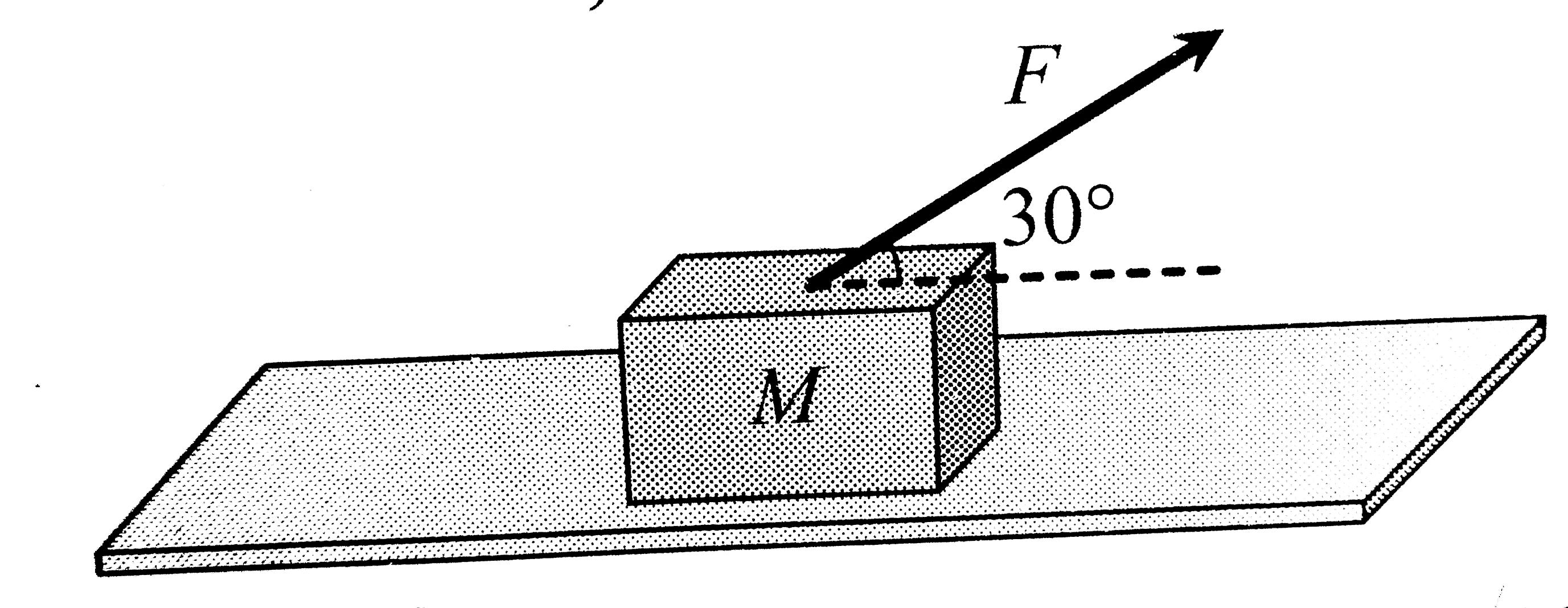A block of mass 10kg is dragged across a horizontal surface by pulling the block with force of 100N. The force is applied by attaching a chord to the block. The chord is inclined at an angle of 60∘ with the horizontal. If the coefficient of kinetic friction is 0.2 what is the acceleration of the block ?
To solve the problem, we will follow these steps:
Step 1: Identify the forces acting on the block
- The weight of the block (W) = mg = 10 kg × 10 m/s² = 100 N (acting downwards).
- The pulling force (F) = 100 N at an angle of 60° with the horizontal.
- The normal force (N) acts upwards from the surface.
- The frictional force (f) acts opposite to the direction of motion.
Step 2: Resolve the pulling force into horizontal and vertical components
- The horizontal component of the pulling force (F_x) = F * cos(θ) = 100 N * cos(60°) = 100 N * 0.5 = 50 N.
- The vertical component of the pulling force (F_y) = F * sin(θ) = 100 N * sin(60°) = 100 N * (√3/2) ≈ 86.6 N.
Step 3: Calculate the normal force (N)
- The normal force can be calculated using the equilibrium of vertical forces:
N+Fy=W
N+86.6N=100N
N=100N−86.6N=13.4N
Step 4: Calculate the frictional force (f)
- The frictional force is given by:
f=μN
where μ is the coefficient of kinetic friction (0.2).
f=0.2×13.4N=2.68N
Step 5: Apply Newton's second law in the horizontal direction
- The net force (F_net) acting on the block in the horizontal direction is:
Fnet=Fx−f
Fnet=50N−2.68N=47.32N
Step 6: Calculate the acceleration (a) of the block
- According to Newton's second law, Fnet=ma:
47.32N=10kg×a
a=47.32N10kg=4.732m/s²
Final Answer
The acceleration of the block is approximately 4.732 m/s².
---
- The weight of the block (W) = mg = 10 kg × 10 m/s² = 100 N (acting downwards).
- The pulling force (F) = 100 N at an angle of 60° with the horizontal.
- The normal force (N) acts upwards from the surface.
- The frictional force (f) acts opposite to the direction of motion.
- The horizontal component of the pulling force (F_x) = F * cos(θ) = 100 N * cos(60°) = 100 N * 0.5 = 50 N.
- The vertical component of the pulling force (F_y) = F * sin(θ) = 100 N * sin(60°) = 100 N * (√3/2) ≈ 86.6 N.
- The normal force can be calculated using the equilibrium of vertical forces:
N+Fy=W
N+86.6N=100N
N=100N−86.6N=13.4N
- The frictional force is given by:
f=μN
where μ is the coefficient of kinetic friction (0.2).
f=0.2×13.4N=2.68N
- The net force (F_net) acting on the block in the horizontal direction is:
Fnet=Fx−f
Fnet=50N−2.68N=47.32N
- According to Newton's second law, Fnet=ma:
47.32N=10kg×a
a=47.32N10kg=4.732m/s²
The acceleration of the block is approximately 4.732 m/s².
Topper's Solved these Questions
- FRICTIONBook:ICSEChapter:FRICTIONExercise:Additional solved examples
Explore 9 Videos
- FRICTIONBook:ICSEChapter:FRICTIONExercise:Conceptual short answer questions with answer
Explore 9 Videos
- DYNAMICSBook:ICSEChapter:DYNAMICSExercise:SHORT ANSWER QUESTIONS WITH ANSWERS
Explore 12 Videos
- GRAVITATIONBook:ICSEChapter:GRAVITATIONExercise:FROM THE HUBBLE TELESCOP
Explore 2 Videos
Similar Questions
A block slides down an inclined plane that makes an angle θ with the horizontal. If the coefficient of kinetic friction is μ, find the acceleration of the block.
View SolutionA wooden block of mass M resting on a rough horizontal surface is pulled with a force T at an angle q to the horizontal. If m is coefficient of kinetic friction between the block and the surface, the acceleration of the block is
View Solution
Knowledge Check
A block of mass 2kg rests on a rough inclined plane making an angle of 30∘ with the horizontal. The coefficient of static friction between the block and the plane is 0.7. The frictional force on the block is
A10.3NB23.8NC11.9ND6.3NA block of mass 3 kg rests on a rough inclined plane making an angle of 30∘. With the horizontal. The coefficient of static friction between the block and the plane is 0.7. The frictional force on the block is
A9.8 NB0.7×9.8×√3 NC9.8×√3 ND0.7×9.8 NA 20 N block is being pushed across a horizontal table by an 18 N force. If the coefficient of kinetic friction between the block and the table is 0.4, find the acceleration of the block.
A0.5m/s2B1m/s2C5m/s2D7.5m/s2
A block of mass 2kg rests on a rough inclined plane making an angle of 30∘ with the horizontal. The coefficient of static friction between the block and the plane is 0.7. The frictional force on the block is
View SolutionA block of mass 10kg is placed on a rough horizontal surface having coefficient of friction μ=0.5 . If a horizontal force of 100N is acting on it, then acceleration of the block will be.
View SolutionA block of mass m=5kg is resting on a rough horizontal surface for which the coefficient of friction is 0.2 . When a force F=40N is applied, the acceleration of the block will be (g=10m/s2) .

View SolutionA block of mass 5 kg is at rest on a rough inclined surface. If angle of inclination of plane is 60∘, then force applied by it on block is
View SolutionA block of mass 10kg is placed on a rough horizontal surface having coefficient of friction μ=0.5 . If a horizontal force of 100N is acting on it, then acceleration of the block will be.
View Solution